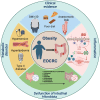Obesity and early-onset colorectal cancer risk: emerging clinical evidence and biological mechanisms
- PMID: 38764574
- PMCID: PMC11100318
- DOI: 10.3389/fonc.2024.1366544
Obesity and early-onset colorectal cancer risk: emerging clinical evidence and biological mechanisms
Abstract
Early-onset colorectal cancer (EOCRC) is defined as diagnosed at younger than 50 years of age and indicates a health burden globally. Patients with EOCRC have distinct risk factors, clinical characteristics, and molecular pathogenesis compared with older patients with CRC. Further investigations have identified different roles of obesity between EOCRC and late-onset colorectal cancer (LOCRC). Most studies have focused on the clinical characteristics of obesity in EOCRC, therefore, the mechanism involved in the association between obesity and EOCRC remains inconclusive. This review further states that obesity affects the carcinogenesis of EOCRC as well as its development and progression, which may lead to obesity-related metabolic syndrome, intestinal dysbacteriosis, and intestinal inflammation.
Keywords: EOCRC; inflammation; intestinal microbe; metabolic syndrome; obesity.
Copyright © 2024 Xu, Tao, Yang and Zhang.
Conflict of interest statement
The authors declare that the research was conducted in the absence of any commercial or financial relationships that could be construed as a potential conflict of interest.
Figures
Similar articles
-
[Epidemiological characteristics of early-onset colorectal cancer: a prospective cohort study from a single center].Zhonghua Wei Chang Wai Ke Za Zhi. 2024 May 25;27(5):457-463. doi: 10.3760/cma.j.cn441530-20240222-00069. Zhonghua Wei Chang Wai Ke Za Zhi. 2024. PMID: 38778685 Chinese.
-
Epidemiology and biology of early onset colorectal cancer.EXCLI J. 2022 Jan 7;21:162-182. doi: 10.17179/excli2021-4456. eCollection 2022. EXCLI J. 2022. PMID: 35221839 Free PMC article. Review.
-
Early Onset Colorectal Cancer in Arabs, Are We Dealing with a Distinct Disease?Cancers (Basel). 2023 Jan 31;15(3):889. doi: 10.3390/cancers15030889. Cancers (Basel). 2023. PMID: 36765846 Free PMC article.
-
Geographic Variation and Risk Factor Association of Early Versus Late Onset Colorectal Cancer.Cancers (Basel). 2023 Feb 4;15(4):1006. doi: 10.3390/cancers15041006. Cancers (Basel). 2023. PMID: 36831350 Free PMC article.
-
Early-onset colorectal cancer: why it should be high on our list of differentials.ANZ J Surg. 2022 Jul;92(7-8):1638-1643. doi: 10.1111/ans.17698. Epub 2022 Apr 21. ANZ J Surg. 2022. PMID: 35451218 Free PMC article. Review.
Cited by
-
The role of physical activity and epigenetic changes in colorectal cancer prevention.Cancer Cell Int. 2025 Jun 22;25(1):227. doi: 10.1186/s12935-025-03872-1. Cancer Cell Int. 2025. PMID: 40545531 Free PMC article. Review.
-
Decoding the genetic and environmental forces in propelling the surge of early-onset colorectal cancer.Chin Med J (Engl). 2025 May 20;138(10):1163-1174. doi: 10.1097/CM9.0000000000003601. Epub 2025 Apr 18. Chin Med J (Engl). 2025. PMID: 40251115 Free PMC article. Review.
-
Obesity-Associated Colorectal Cancer.Int J Mol Sci. 2024 Aug 14;25(16):8836. doi: 10.3390/ijms25168836. Int J Mol Sci. 2024. PMID: 39201522 Free PMC article. Review.
-
Colorectal Cancer in Elderly Patients: Insights into Presentations, Prognosis, and Patient Outcomes.Medicina (Kaunas). 2024 Nov 26;60(12):1951. doi: 10.3390/medicina60121951. Medicina (Kaunas). 2024. PMID: 39768833 Free PMC article.
-
Trends in childhood cancer: Incidence and survival analysis over 45 years of SEER data.PLoS One. 2025 Jan 3;20(1):e0314592. doi: 10.1371/journal.pone.0314592. eCollection 2025. PLoS One. 2025. PMID: 39752445 Free PMC article.
References
-
- Ng M, Fleming T, Robinson M, Thomson B, Graetz N, Margono C, et al. . Global, regional, and national prevalence of overweight and obesity in children and adults during 1980-2013: a systematic analysis for the Global Burden of Disease Study 2013. Lancet. (2014) 384:766–81. doi: 10.1016/S0140-6736(14)60460-8 - DOI - PMC - PubMed
Publication types
LinkOut - more resources
Full Text Sources



